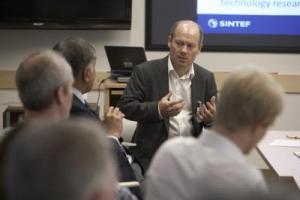May 20 2014
A decades-long partnership between Sandia National Laboratories and the Norwegian research organization SINTEF (Stiftelsen for industriell og teknisk forskning) will now tackle energy challenges such as renewable energy integration, electric grid modernization, gas technologies and algae-based biofuels, under an expanded agreement.
 Inge Gran, president of SINTEF Energy Research, visited Sandia National Laboratories recently to discuss an enhancement to SINTEF's decades-long collaboration with the labs. Under an expanded agreement, the two organizations will now tackle a variety of energy challenges. (Credit: Jeff McMillan, Sandia National Laboratories)
Inge Gran, president of SINTEF Energy Research, visited Sandia National Laboratories recently to discuss an enhancement to SINTEF's decades-long collaboration with the labs. Under an expanded agreement, the two organizations will now tackle a variety of energy challenges. (Credit: Jeff McMillan, Sandia National Laboratories)
SINTEF is the largest independent research organization in Scandinavia, with expertise in the natural sciences and technology, the environment, health and social sciences. Its specific technical strengths include oil and gas, materials, maritime and biomarine technology, building research and medical technology. The agreement includes close alignment with the Norwegian University of Science and Technology in Trondheim, the largest technical university in Norway.
Sandia has partnered with SINTEF since the 1980s, primarily in the field of combustion science at the lab's Combustion Research Facility. A memorandum of understanding between the two organizations was signed in 2009. Past joint research has included the use of laser diagnostics to study a new combustion technology that allows carbon-dioxide to be captured from the combustion products, and advanced numerical simulations of the turbulent mixing and combustion of fuel jets in air. This collaboration led to publications reporting important insights into the consequences of replacing carbon-dioxide-emitting fuels with environmentally friendly fuel in power generation.
Recently, research managers from SINTEF visited Sandia's California and New Mexico sites to plan the enhanced collaboration.
"Sandia and SINTEF are among the world's leading energy research institutions, and expanding the areas of collaboration is expected to bring new solutions to these difficult energy problems," said Bob Hwang, director of the Transportation Energy Center at Sandia. "This partnership can make important strides toward our nation's goals in energy security."
The goal of the collaboration is to investigate various technical areas from an international perspective. The agreement enables the organizations to undertake joint research, seek new funding opportunities and establish multidisciplinary partnerships. Both research organizations are known for groundbreaking work in energy research.
"Sandia offers a number of unique capabilities and significant test facilities, and we look forward to leveraging these resources in collaborating with SINTEF to advance our mutual goals," said Juan Torres, senior manager of Sandia's renewable energy technologies group. In addition to the Combustion Research Facility, Sandia's energy research facilities include the Photovoltaic Systems Evaluation Lab, the Distributed Energy Technologies Laboratory and the Department of Energy's National Solar Thermal Test Facility.
"SINTEF is delighted to partner with Sandia to advance research in additional energy areas, along with our longstanding collaboration in combustion research," said Inge Gran, president of SINTEF Energy Research. "The expanded areas of collaboration recognize the relationship we have already had with Sandia for several decades, and they point to a strong collaborative future."